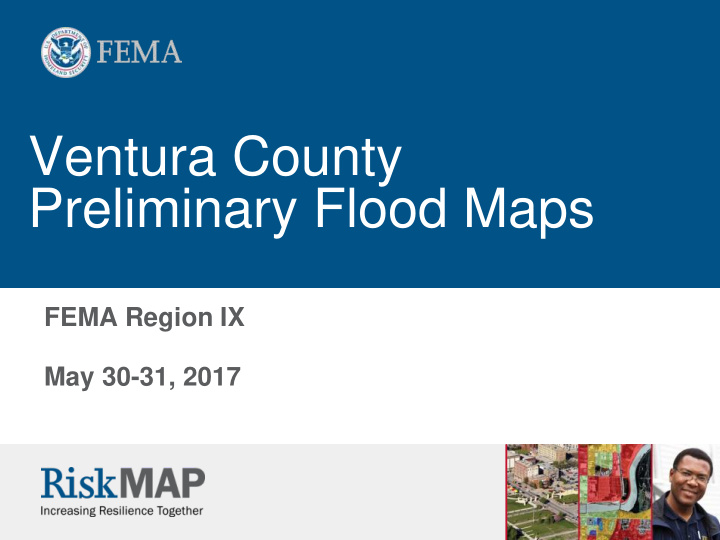



Ventura County Preliminary Flood Maps FEMA Region IX May 30-31, 2017
National Flood Insurance Program U.S. Congress established the NFIP with the passage of the National Flood Insurance Act of 1968: FEMA produces Flood Insurance Rate Maps 1. Communities adopt and enforce a floodplain 2. management ordinance to reduce flood risk to new and existing development in high risk flood zones Federal government makes flood insurance 3. available to property owners in participating communities 2
What is a FEMA Flood Insurance Rate Map (FIRM)? 3
Open Pacific Coast Study
California Coastal Analysis and Mapping Project Two Companion Large-Scale Efforts: Open Pacific Coast (OPC) Study San Francisco Bay Area Coastal (BAC) Study Re-study flood risk Re-map the elevation and inland extent of along the open coast wave-induced coastal and inland bays of all flooding California coastal counties www.r9coastal.org 5
Open Pacific Coast Study Del Norte Humboldt Mendocino Phase 1 Sonoma Northern & Central California Coast Marin San Francisco San Mateo Santa Cruz Monterey San Luis Obispo Santa Barbara Ventura Phase 2 Los Angeles Southern California Coast Orange San Diego 6
Ventura County Flood Mapping Timeline Kick-Off Meeting Flood Risk Review Meeting Preliminary FIRM Meeting Public Meeting December 8, 2011 October 26, 2015 October 19, 2016 TODAY Outreach Timeline Provide Work Map Develop Community Implement Study Data Comment Tool Outreach Plan Outreach Plan Data Coastal Floodplain Prelim. Map Post-Preliminary Acquisition Analysis Mapping Production Process Map Production Timeline July 2018 Appeal Period Jan. 2018 June 9 – Sept. 6, 2017 Letter of Final Determination (LFD) Effective Maps 7
Coastal Study Process
Coastal Study Infographic • FEMA’s coastal study summary describes key steps in the process • Available online at: https://www.fema.gov/media- library/assets/documents/1161 60 9
Wave Runup and Overtopping 10
Wave Overtopping Photo: Lesley Ewing (from FEMA Coastal Construction Manual) Photo: Justin Vandever, BakerAECOM During severe coastal storm events along the Pacific coast, high waves and wave runup can overtop coastal barriers including bluffs, dunes, seawalls, revetments, and beach berms. https://www.youtube.com/watch?v=0SczjJCCpRI 11
Flood Hazard Mapping Zone VE: Inundated by 1-percent annual chance (100- year) flood with additional wave hazards: Runup Overtopping Zone AE: Inundated by 1-percent annual chance flood Zone X (shaded): Inundated by 0.2-percent annual chance (500-year) flood Zones VE and AE carry mandatory flood insurance purchase requirements 12
Flood Hazard Mapping Point Mugu, Transect 68 Effective FIRM: 2016 OPC Preliminary FIRM: Zone D Zones VE 19 Zone D AE 8 VE 19 68 68 13
Changes Since Last FIRM www.r9coastal.org 14
Floodplain Management
Floodplain Management and Insurance – LOMA Scenario 1 (OAS) 16
Floodplain Management and Insurance – LOMA Scenario 2 17
Floodplain Management Scenario #1: X to VE Historic structure exemption Substantial Improvement and Substantial Damage • Existing Building - Tenant improvements that are <50% of market value are allowed • Existing Building - Tenant improvements that are >50% of market value can be permitted provided they meet all Zone VE regulations except for 60.3 (e) (3). New construction is NOT allowed seaward of mean high tide. In VE Zones, new construction must have the elevation of the lowest horizontal structural member at or above the Base Flood Elevation (BFE). 18
Floodplain Management Scenario #2: X to AE Standards to ensure new construction and substantial improvement will be protected from the base flood Elevate structures Floodproof (nonresidential structures only) 19
Next Steps FEMA Actions Publish notice of formal appeal period in local newspapers Initiate formal appeal period (June 9 – Sept. 6, 2017) Community Actions Review preliminary FIRM panels Understand FEMA’s comment/appeal process: https://www.fema.gov/media-library/assets/documents/17930 Submit comments to local Floodplain Manager 20
Flood Insurance Information
How the NFIP Works FEMA agrees to make flood insurance available within a community when that community agrees to adopt and enforce floodplain management regulations. 22
Maximum Flood Insurance Available Occupancy Building Contents Residential 250,000 100,000 Non-Residential (Commercial) 500,000 500,000 23
How Do I Purchase Flood Insurance? Contact Your Local Insurance Agent 24
When is Flood Insurance Required? Buildings in A and V zones with Federally backed loans 25
How Much Flood Insurance is Required? Lender Decision: Outstanding loan balance Maximum available Replacement cost or actual cash value 26
Cost of Flood Insurance 27
Possible Impacts of New Map 1. Newly mapped into a high risk area 2. Removed from the high risk area 3. Change in type of high risk area 4. Change in how high water gets 28
Contact Your Insurance Agent Early to Discuss Options 29
Where to Get More Information http://www.fema.gov/nfip 30
31
Recommend
More recommend